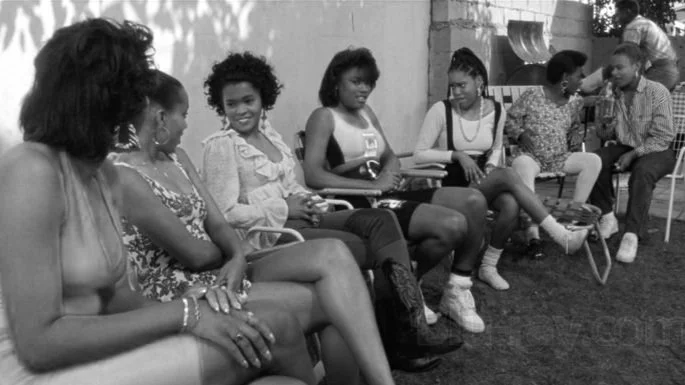During February of my 2025 movie-every-day challenge, I decided to only watch films by Black directors. I made a Letterboxd list called Black Card and filled it with all the movies I’ve been yelled at for not having seen yet.
The first one I watched was Malcolm X by Spike Lee. I was a little put off by the way women were treated in the story, but I brushed it off—like, okay, it’s about the guy. But the more films I watched on that list, the more I started noticing it everywhere. The treatment of women in a lot of these films was pretty disappointing.
Even The United States vs. Billie Holiday couldn’t center its lead without making her suffering feel like the entire point.
The worst offender, however (at least for me), was Boyz n the Hood. Probably because of how influential the film is, and because of one specific plot point I’ll get into later. The portrayal of women totally took me out of the movie. Usually, I can just notice it and move on, but it was genuinely distracting.
Weirdly, the movie that felt like a breath of fresh air was House Party. I didn’t even like it that much. But it was so refreshing to see how the women were treated by the filmmakers—as full people.
These two films came out around the same time and deal with similar subject matter, so it really stood out to me how different their approaches were. One largely sidelines women, while the other makes space for them to feel like full characters. I want to look at Boyz n the Hood and House Party side by side, and think through what it means when women are included in the story—or left out of it.
boyz in the hood (1991)
Let me start by saying that I loved this movie. I very much understand why it’s so iconic. My favorite part by far (besides Ice Cube) was the sound design. It was incredible—the constant hum of helicopters and sirens gives the whole film a sense of tension that never lets up. It's the soundtrack to their lives. The cinematography is beautiful, and the performances feel grounded and real.
But… the treatment of women is rough.
There’s a moment early on when Shalika asks Dooky, “Why do you always call me a bitch or a hoe?” and he just goes, “Because that’s what you are.” That’s it. No follow-up, no irony, no pushback—just blatant sexism, played straight. And that line pretty much encapsulates how most women are handled in the film. They’re unnamed, underwritten, or reduced to roles like someone’s mom or someone’s girl.
When Brandi and her arc were first introduced, I was really excited to see how it would turn out. She starts out clear about her values—waiting until marriage, setting boundaries, and pushing back when Tre acts immature. She felt like one of the few women in the film with a point of view. But then out of nowhere, she just sleeps with him. There’s no real shift in their relationship, no moment where she changes her mind or explains what she’s feeling. It doesn’t feel like growth—it feels like the film just decided her arc was over once she gave Tre what he wanted. It turns a promising character into a plot device, and that was really disappointing to watch.
I know the film is about fatherhood and growing up Black and male in South Central, and it does that part well. That, however, doesn’t mean women have to be flattened in the process.
“Although Boyz n the Hood seeks to enfranchise young black men by putting their stories on screen, it reaffirms the dominant view of black women, casting them as either unnecessary or a problem rather than equal partners with a part to play in changing the conditions of the neighbourhood.”
— Manning Up: Race, Gender and Violence in Boyz n the Hood, Michele Wallace
house party (1990)
Again, I didn’t really like House Party. It just wasn’t that funny to me. Also, I refuse to believe this guy can pull.
But to my surprise, I ended up really appreciating how the women were treated. The female characters felt like full people. Sidney and Sharane get to be funny, loud, flirty, smart, corny, annoyed, and confident. And they aren’t punished for it! They’re not just there to make the boys look cool or move the story along. They’re actually part of the plot, with desires and flaws.
Sidney wants to take things slow and have some control over how the night plays out. Sharane wants to have fun and look good doing it—but she’s also got real tension with Sidney, and the movie lets them disagree without turning either of them into a villain. Even smaller characters, like Kid’s dad’s girlfriend or the background girls at the party, have little moments that show personality. It’s not deep feminist cinema or anything—but it feels lived-in, like the filmmakers actually knew girls like this and respected them enough to let them show up fully.
When you compare it to other hood movies from the same era, where girls are mostly left out or flattened into tropes, House Party just lets them exist. That shouldn’t feel radical, but it kind of does.
“These characters are not stereotypes, not bullet-stoppers, not the butt of cruel jokes. They are kids, like kids anywhere, with more than their share of good humor and hard luck.”
— Roger Ebert (my friend, my foe)
Again, I’m not saying every movie needs to be more than half women, or even just pass the Bechdel test (though that would be nice). I do think it’s worth thinking about though, especially in movies that are so influential.
Also, I think Spike Lee hates women—but that’s a whole other essay.



